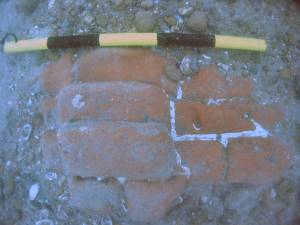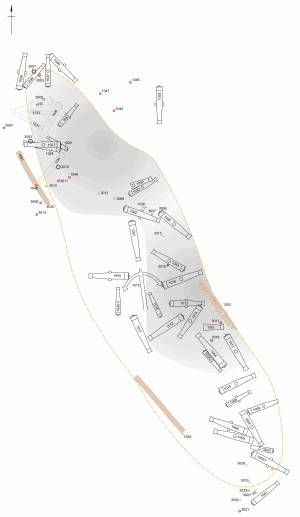The site known as the Norman's Bay Wreck was discovered in 2005 by a local diver when he was asked to remove a snagged lobster pot by a local fisherman. He discovered a large anchor and a pile of guns, and then contacted Peter Marsden of the Shipwreck Heritage Centre in Hastings and English Heritage to report the find.
 is consistent with a number of known Dutch vessels to have been lost in the area.
From the timber remains it has been suggested that the vessel would have been 40 metres long with an appropriate breadth of 12 meters. Other dating evidence is sparse although it has been possible to suggest that the wreck dates between the 16th and 18th Century from the bricks type, the gun quantity and size, and the anchor sizes.
The site was designated as a protected historic wreck site in 2006. The wreck is now owned by the Nautical Museum's Trust.
Wessex Archaeology's Diving Investigations
Wessex Archaeology was asked by English Heritage to investigate the wreck as part of our work under the Protection of Wrecks Act (1973) in 2005, and was followed by other visits in 2006 and 2007.
is consistent with a number of known Dutch vessels to have been lost in the area.
From the timber remains it has been suggested that the vessel would have been 40 metres long with an appropriate breadth of 12 meters. Other dating evidence is sparse although it has been possible to suggest that the wreck dates between the 16th and 18th Century from the bricks type, the gun quantity and size, and the anchor sizes.
The site was designated as a protected historic wreck site in 2006. The wreck is now owned by the Nautical Museum's Trust.
Wessex Archaeology's Diving Investigations
Wessex Archaeology was asked by English Heritage to investigate the wreck as part of our work under the Protection of Wrecks Act (1973) in 2005, and was followed by other visits in 2006 and 2007. During the three diving investigations Wessex Archaeology recorded the key features of the wreck including the anchor, the guns and the bricks in order to produce an accurate site plan. Also as a part of the investigations the timbers were inspected and assessed as to determine those best suited for dendrochronological sampling, 11 samples for dating and origin analysis were selected and taken from the site.
Following the diving investigation Wessex Archaeology concluded that the features present on the wreck fitted several other known vessels to have been lost in the area and therefore the current evidence was insufficient to identify the wreck for sure.
A copy of the full report of Wessex Archaeology's investigations can be downloaded as a .pdf below.
INSERT PDF REPORT
During the three diving investigations Wessex Archaeology recorded the key features of the wreck including the anchor, the guns and the bricks in order to produce an accurate site plan. Also as a part of the investigations the timbers were inspected and assessed as to determine those best suited for dendrochronological sampling, 11 samples for dating and origin analysis were selected and taken from the site.
Following the diving investigation Wessex Archaeology concluded that the features present on the wreck fitted several other known vessels to have been lost in the area and therefore the current evidence was insufficient to identify the wreck for sure.
A copy of the full report of Wessex Archaeology's investigations can be downloaded as a .pdf below.
INSERT PDF REPORT

 is consistent with a number of known Dutch vessels to have been lost in the area.
From the timber remains it has been suggested that the vessel would have been 40 metres long with an appropriate breadth of 12 meters. Other dating evidence is sparse although it has been possible to suggest that the wreck dates between the 16th and 18th Century from the bricks type, the gun quantity and size, and the anchor sizes.
The site was designated as a protected historic wreck site in 2006. The wreck is now owned by the Nautical Museum's Trust.
Wessex Archaeology's Diving Investigations
Wessex Archaeology was asked by English Heritage to investigate the wreck as part of our work under the Protection of Wrecks Act (1973) in 2005, and was followed by other visits in 2006 and 2007.
is consistent with a number of known Dutch vessels to have been lost in the area.
From the timber remains it has been suggested that the vessel would have been 40 metres long with an appropriate breadth of 12 meters. Other dating evidence is sparse although it has been possible to suggest that the wreck dates between the 16th and 18th Century from the bricks type, the gun quantity and size, and the anchor sizes.
The site was designated as a protected historic wreck site in 2006. The wreck is now owned by the Nautical Museum's Trust.
Wessex Archaeology's Diving Investigations
Wessex Archaeology was asked by English Heritage to investigate the wreck as part of our work under the Protection of Wrecks Act (1973) in 2005, and was followed by other visits in 2006 and 2007. During the three diving investigations Wessex Archaeology recorded the key features of the wreck including the anchor, the guns and the bricks in order to produce an accurate site plan. Also as a part of the investigations the timbers were inspected and assessed as to determine those best suited for dendrochronological sampling, 11 samples for dating and origin analysis were selected and taken from the site.
Following the diving investigation Wessex Archaeology concluded that the features present on the wreck fitted several other known vessels to have been lost in the area and therefore the current evidence was insufficient to identify the wreck for sure.
A copy of the full report of Wessex Archaeology's investigations can be downloaded as a .pdf below.
INSERT PDF REPORT
During the three diving investigations Wessex Archaeology recorded the key features of the wreck including the anchor, the guns and the bricks in order to produce an accurate site plan. Also as a part of the investigations the timbers were inspected and assessed as to determine those best suited for dendrochronological sampling, 11 samples for dating and origin analysis were selected and taken from the site.
Following the diving investigation Wessex Archaeology concluded that the features present on the wreck fitted several other known vessels to have been lost in the area and therefore the current evidence was insufficient to identify the wreck for sure.
A copy of the full report of Wessex Archaeology's investigations can be downloaded as a .pdf below.
INSERT PDF REPORT